air suspension KIA NIRO 2018 User Guide
[x] Cancel search | Manufacturer: KIA, Model Year: 2018, Model line: NIRO, Model: KIA NIRO 2018Pages: 616, PDF Size: 18.3 MB
Page 488 of 616
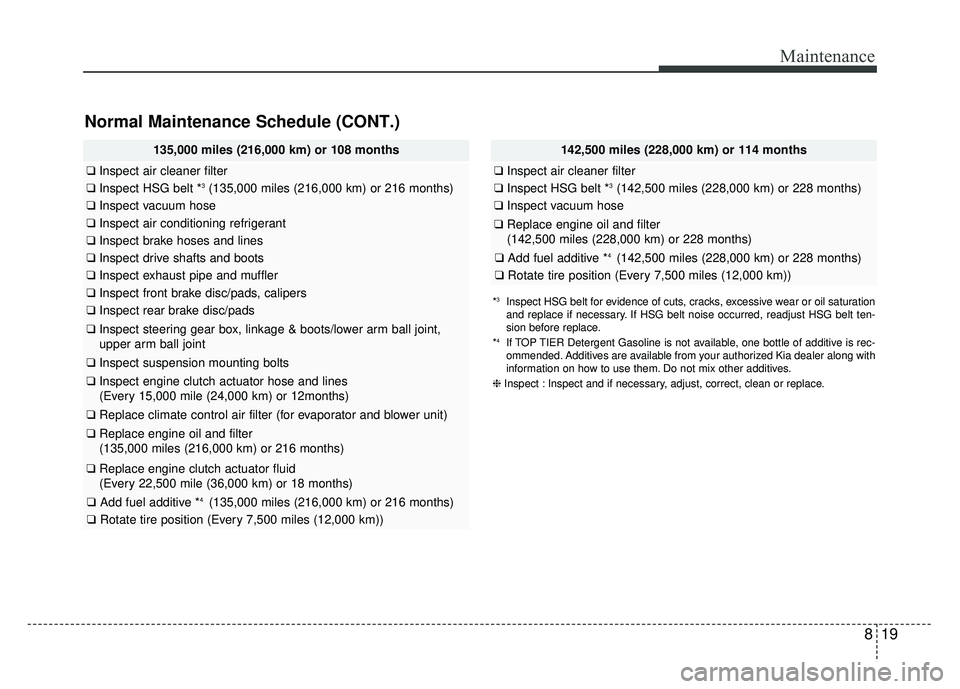
819
Maintenance
Normal Maintenance Schedule (CONT.)
135,000 miles (216,000 km) or 108 months
❑Inspect air cleaner filter
❑Inspect HSG belt *3(135,000 miles (216,000 km) or 216 months)
❑Inspect vacuum hose
❑Inspect air conditioning refrigerant
❑Inspect brake hoses and lines
❑Inspect drive shafts and boots
❑Inspect exhaust pipe and muffler
❑Inspect front brake disc/pads, calipers
❑Inspect rear brake disc/pads
❑Inspect steering gear box, linkage & boots/lower arm ball joint,
upper arm ball joint
❑ Inspect suspension mounting bolts
❑Inspect engine clutch actuator hose and lines
(Every 15,000 mile (24,000 km) or 12months)
❑ Replace climate control air filter (for evaporator and blower unit)
❑Replace engine oil and filter
(135,000 miles (216,000 km) or 216 months)
❑Replace engine clutch actuator fluid
(Every 22,500 mile (36,000 km) or 18 months)
❑ Add fuel additive *4 (135,000 miles (216,000 km) or 216 months)
❑Rotate tire position (Every 7,500 miles (12,000 km))
142,500 miles (228,000 km) or 114 months
❑Inspect air cleaner filter
❑Inspect HSG belt *3(142,500 miles (228,000 km) or 228 months)
❑Inspect vacuum hose
❑Replace engine oil and filter
(142,500 miles (228,000 km) or 228 months)
❑ Add fuel additive *4 (142,500 miles (228,000 km) or 228 months)
❑Rotate tire position (Every 7,500 miles (12,000 km))
*3Inspect HSG belt for evidence of cuts, cracks, excessive wear or oil saturation
and replace if necessary. If HSG belt noise occurred, readjust HSG belt ten-
sion before replace.
*
4If TOP TIER Detergent Gasoline is not available, one bottle of additive is rec-
ommended. Additives are available from your authorized Kia dealer along with
information on how to use them. Do not mix other additives.
❈ Inspect : Inspect and if necessary, adjust, correct, clean or replace.
Page 489 of 616
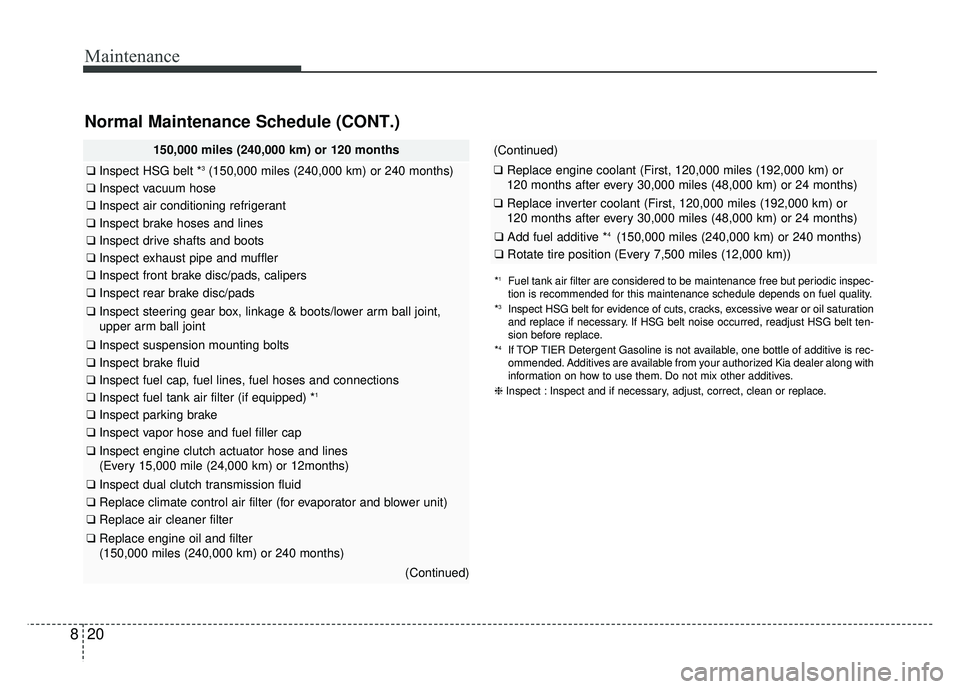
Maintenance
20
8
Normal Maintenance Schedule (CONT.)
150,000 miles (240,000 km) or 120 months
❑ Inspect HSG belt *3(150,000 miles (240,000 km) or 240 months)
❑Inspect vacuum hose
❑Inspect air conditioning refrigerant
❑Inspect brake hoses and lines
❑Inspect drive shafts and boots
❑Inspect exhaust pipe and muffler
❑Inspect front brake disc/pads, calipers
❑Inspect rear brake disc/pads
❑Inspect steering gear box, linkage & boots/lower arm ball joint,
upper arm ball joint
❑ Inspect suspension mounting bolts
❑Inspect brake fluid
❑Inspect fuel cap, fuel lines, fuel hoses and connections
❑Inspect fuel tank air filter (if equipped) *1
❑Inspect parking brake
❑Inspect vapor hose and fuel filler cap
❑Inspect engine clutch actuator hose and lines
(Every 15,000 mile (24,000 km) or 12months)
❑ Inspect dual clutch transmission fluid
❑Replace climate control air filter (for evaporator and blower unit)
❑Replace air cleaner filter
❑Replace engine oil and filter
(150,000 miles (240,000 km) or 240 months)
(Continued)
(Continued)
❑Replace engine coolant (First, 120,000 miles (192,000 km) or
120 months after every 30,000 miles (48,000 km) or 24 months)
❑Replace inverter coolant (First, 120,000 miles (192,000 km) or
120 months after every 30,000 miles (48,000 km) or 24 months)
❑ Add fuel additive *4 (150,000 miles (240,000 km) or 240 months)
❑Rotate tire position (Every 7,500 miles (12,000 km))
*1Fuel tank air filter are considered to be maintenance free but periodic inspec-
tion is recommended for this maintenance schedule depends on fuel quality.
*
3Inspect HSG belt for evidence of cuts, cracks, excessive wear or oil saturation
and replace if necessary. If HSG belt noise occurred, readjust HSG belt ten-
sion before replace.
*
4If TOP TIER Detergent Gasoline is not available, one bottle of additive is rec-
ommended. Additives are available from your authorized Kia dealer along with
information on how to use them. Do not mix other additives.
❈ Inspect : Inspect and if necessary, adjust, correct, clean or replace.
Page 490 of 616
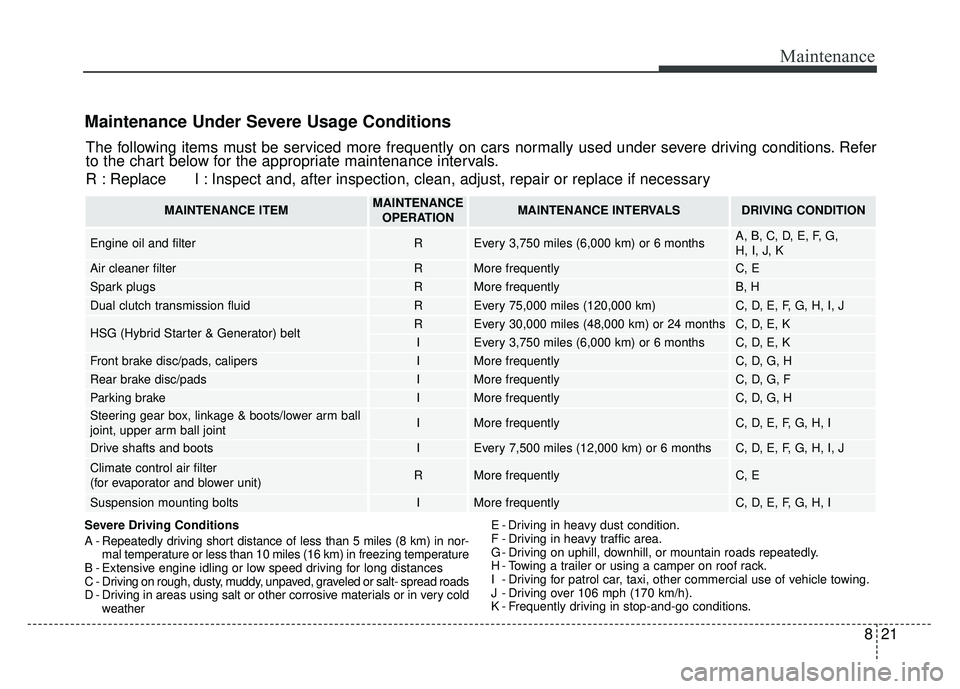
821
Maintenance
Maintenance Under Severe Usage Conditions
Severe Driving Conditions
A - Repeatedly driving short distance of less than 5 miles (8 km) in nor-mal temperature or less than 10 miles (16 km) in freezing temperature
B - Extensive engine idling or low speed driving for long distances
C - Driving on rough, dusty, muddy, unpaved, graveled or salt- spread roads
D - Driving in areas using salt or other corrosive materials or in very cold weather E - Driving in heavy dust condition.
F - Driving in heavy traffic area.
G - Driving on uphill, downhill, or mountain roads repeatedly.
H - Towing a trailer or using a camper on roof rack.
I - Driving for patrol car, taxi, other commercial use of vehicle towing.
J - Driving over 106 mph (170 km/h).
K - Frequently driving in stop-and-go conditions.
The following items must be serviced more frequently on cars normally used under severe driving conditions. Refer
to the chart below for the appropriate maintenance intervals.
R : Replace I : Inspect and, after inspection, clean, adjust, repair or replace if neces\
sary
MAINTENANCE ITEMMAINTENANCE
OPERATIONMAINTENANCE INTERVALSDRIVING CONDITION
Engine oil and filter REvery 3,750 miles (6,000 km) or 6 monthsA, B, C, D, E, F, G,
H, I, J, K
Air cleaner filterRMore frequentlyC, E
Spark plugsRMore frequentlyB, H
Dual clutch transmission fluid REvery 75,000 miles (120,000 km)C, D, E, F, G, H, I, J
HSG (Hybrid Starter & Generator) beltREvery 30,000 miles (48,000 km) or 24 monthsC, D, E, K
IEvery 3,750 miles (6,000 km) or 6 monthsC, D, E, K
Front brake disc/pads, calipersIMore frequentlyC, D, G, H
Rear brake disc/padsIMore frequentlyC, D, G, F
Parking brakeIMore frequentlyC, D, G, H
Steering gear box, linkage & boots/lower arm ball
joint, upper arm ball jointIMore frequentlyC, D, E, F, G, H, I
Drive shafts and bootsIEvery 7,500 miles (12,000 km) or 6 monthsC, D, E, F, G, H, I, J
Climate control air filter
(for evaporator and blower unit)RMore frequentlyC, E
Suspension mounting boltsIMore frequentlyC, D, E, F, G, H, I
Page 494 of 616
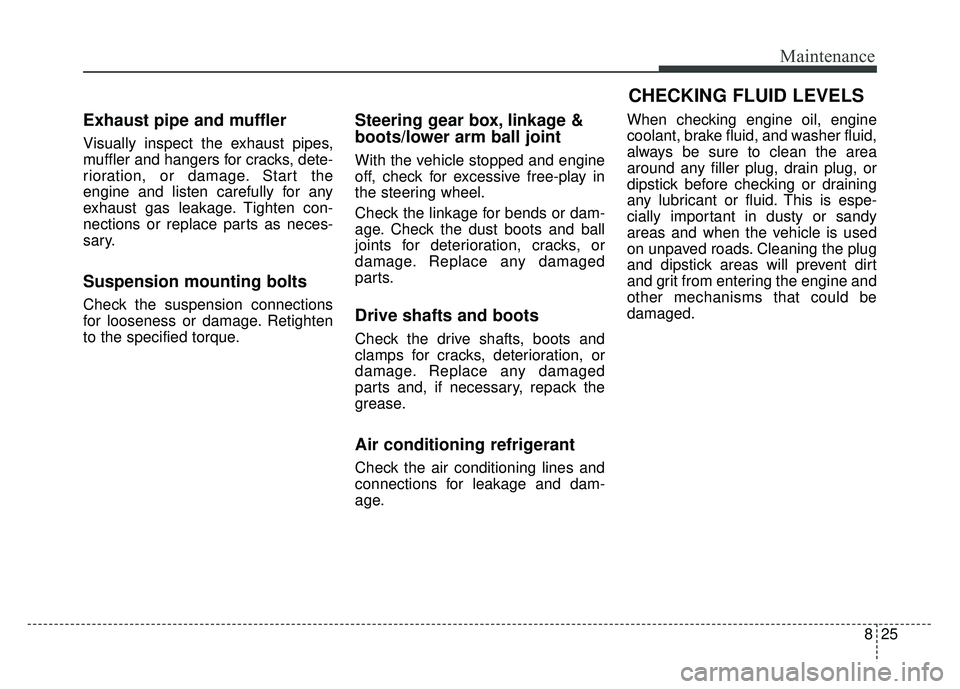
825
Maintenance
Exhaust pipe and muffler
Visually inspect the exhaust pipes,
muffler and hangers for cracks, dete-
rioration, or damage. Start the
engine and listen carefully for any
exhaust gas leakage. Tighten con-
nections or replace parts as neces-
sary.
Suspension mounting bolts
Check the suspension connections
for looseness or damage. Retighten
to the specified torque.
Steering gear box, linkage &
boots/lower arm ball joint
With the vehicle stopped and engine
off, check for excessive free-play in
the steering wheel.
Check the linkage for bends or dam-
age. Check the dust boots and ball
joints for deterioration, cracks, or
damage. Replace any damaged
parts.
Drive shafts and boots
Check the drive shafts, boots and
clamps for cracks, deterioration, or
damage. Replace any damaged
parts and, if necessary, repack the
grease.
Air conditioning refrigerant
Check the air conditioning lines and
connections for leakage and dam-
age.When checking engine oil, engine
coolant, brake fluid, and washer fluid,
always be sure to clean the area
around any filler plug, drain plug, or
dipstick before checking or draining
any lubricant or fluid. This is espe-
cially important in dusty or sandy
areas and when the vehicle is used
on unpaved roads. Cleaning the plug
and dipstick areas will prevent dirt
and grit from entering the engine and
other mechanisms that could be
damaged.
CHECKING FLUID LEVELS
Page 576 of 616
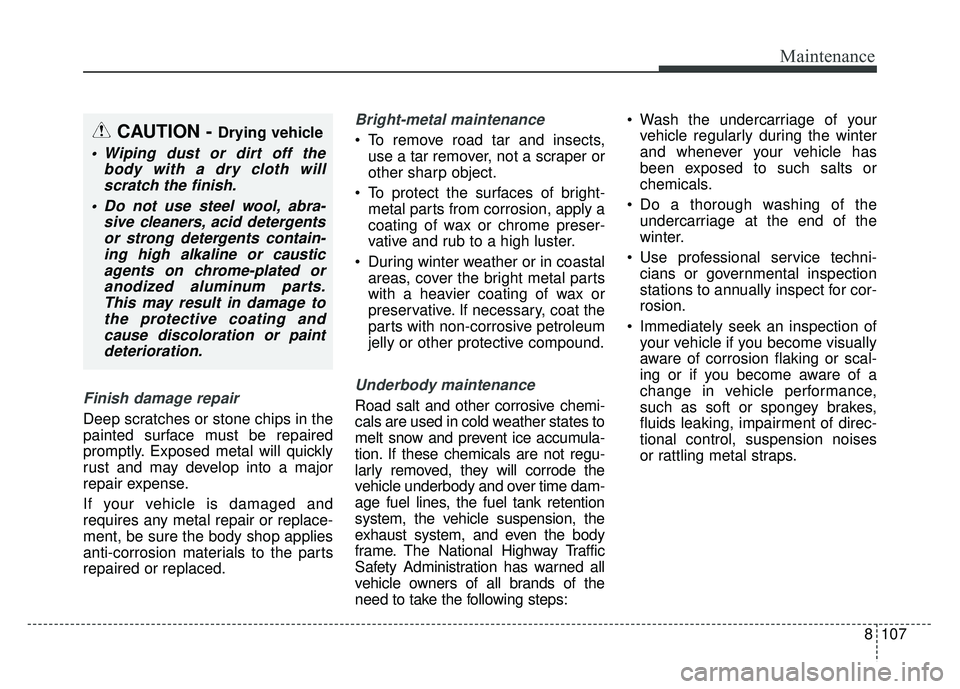
8107
Maintenance
Finish damage repair
Deep scratches or stone chips in the
painted surface must be repaired
promptly. Exposed metal will quickly
rust and may develop into a major
repair expense.
If your vehicle is damaged and
requires any metal repair or replace-
ment, be sure the body shop applies
anti-corrosion materials to the parts
repaired or replaced.
Bright-metal maintenance
To remove road tar and insects,use a tar remover, not a scraper or
other sharp object.
To protect the surfaces of bright- metal parts from corrosion, apply a
coating of wax or chrome preser-
vative and rub to a high luster.
During winter weather or in coastal areas, cover the bright metal parts
with a heavier coating of wax or
preservative. If necessary, coat the
parts with non-corrosive petroleum
jelly or other protective compound.
Underbody maintenance
Road salt and other corrosive chemi-
cals are used in cold weather states to
melt snow and prevent ice accumula-
tion. If these chemicals are not regu-
larly removed, they will corrode the
vehicle underbody and over time dam-
age fuel lines, the fuel tank retention
system, the vehicle suspension, the
exhaust system, and even the body
frame. The National Highway Traffic
Safety Administration has warned all
vehicle owners of all brands of the
need to take the following steps: Wash the undercarriage of your
vehicle regularly during the winter
and whenever your vehicle has
been exposed to such salts or
chemicals.
Do a thorough washing of the undercarriage at the end of the
winter.
Use professional service techni- cians or governmental inspection
stations to annually inspect for cor-
rosion.
Immediately seek an inspection of your vehicle if you become visually
aware of corrosion flaking or scal-
ing or if you become aware of a
change in vehicle performance,
such as soft or spongey brakes,
fluids leaking, impairment of direc-
tional control, suspension noises
or rattling metal straps.
CAUTION - Drying vehicle
Wiping dust or dirt off the body with a dry cloth willscratch the finish.
Do not use steel wool, abra- sive cleaners, acid detergentsor strong detergents contain-ing high alkaline or causticagents on chrome-plated oranodized aluminum parts.This may result in damage tothe protective coating andcause discoloration or paintdeterioration.
Page 607 of 616
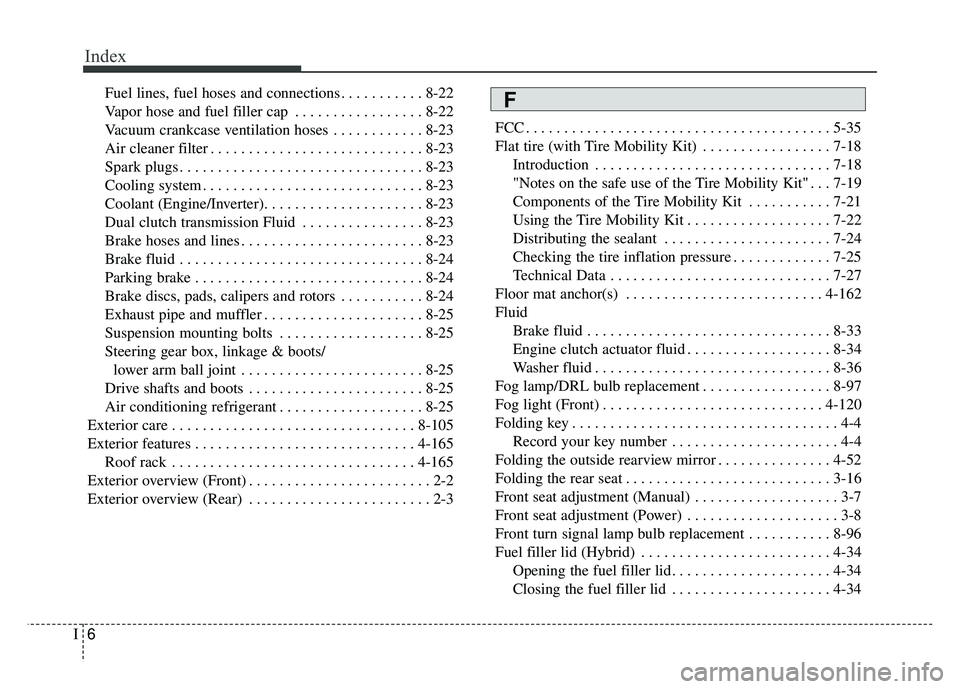
Index
6I
Fuel lines, fuel hoses and connections . . . . . . . . . . . 8-22
Vapor hose and fuel filler cap . . . . . . . . . . . . . . . . . 8-22
Vacuum crankcase ventilation hoses . . . . . . . . . . . . 8-23
Air cleaner filter . . . . . . . . . . . . . . . . . . . . . . . . . . . . 8-23
Spark plugs . . . . . . . . . . . . . . . . . . . . . . . . . . . . . . . . 8-23
Cooling system . . . . . . . . . . . . . . . . . . . . . . . . . . . . . 8-23
Coolant (Engine/Inverter). . . . . . . . . . . . . . . . . . . . . 8-23
Dual clutch transmission Fluid . . . . . . . . . . . . . . . . 8-23
Brake hoses and lines . . . . . . . . . . . . . . . . . . . . . . . . 8-23
Brake fluid . . . . . . . . . . . . . . . . . . . . . . . . . . . . . . . . 8-24
Parking brake . . . . . . . . . . . . . . . . . . . . . . . . . . . . . . 8-24
Brake discs, pads, calipers and rotors . . . . . . . . . . . 8-24
Exhaust pipe and muffler . . . . . . . . . . . . . . . . . . . . . 8-25
Suspension mounting bolts . . . . . . . . . . . . . . . . . . . 8-25
Steering gear box, linkage & boots/lower arm ball joint . . . . . . . . . . . . . . . . . . . . . . . . 8-25
Drive shafts and boots . . . . . . . . . . . . . . . . . . . . . . . 8-25
Air conditioning refrigerant . . . . . . . . . . . . . . . . . . . 8-25
Exterior care . . . . . . . . . . . . . . . . . . . . . . . . . . . . . . . . 8-105
Exterior features . . . . . . . . . . . . . . . . . . . . . . . . . . . . . 4-165 Roof rack . . . . . . . . . . . . . . . . . . . . . . . . . . . . . . . . 4-165
Exterior overview (Front) . . . . . . . . . . . . . . . . . . . . . . . . 2-2
Exterior overview (Rear) . . . . . . . . . . . . . . . . . . . . . . . . 2-3 FCC . . . . . . . . . . . . . . . . . . . . . . . . . . . . . . . . . . . . \
. . . . 5-35
Flat tire (with Tire Mobility Kit) . . . . . . . . . . . . . . . . . 7-18
Introduction . . . . . . . . . . . . . . . . . . . . . . . . . . . . . . . 7-18
"Notes on the safe use of the Tire Mobility Kit" . . . 7-19
Components of the Tire Mobility Kit . . . . . . . . . . . 7-21
Using the Tire Mobility Kit . . . . . . . . . . . . . . . . . . . 7-22
Distributing the sealant . . . . . . . . . . . . . . . . . . . . . . 7-24
Checking the tire inflation pressure . . . . . . . . . . . . . 7-25
Technical Data . . . . . . . . . . . . . . . . . . . . . . . . . . . . . 7-27
Floor mat anchor(s) . . . . . . . . . . . . . . . . . . . . . . . . . . 4-162
Fluid Brake fluid . . . . . . . . . . . . . . . . . . . . . . . . . . . . . . . . 8-33
Engine clutch actuator fluid . . . . . . . . . . . . . . . . . . . 8-34
Washer fluid . . . . . . . . . . . . . . . . . . . . . . . . . . . . . . . 8-36
Fog lamp/DRL bulb replacement . . . . . . . . . . . . . . . . . 8-97
Fog light (Front) . . . . . . . . . . . . . . . . . . . . . . . . . . . . . 4-120
Folding key . . . . . . . . . . . . . . . . . . . . . . . . . . . . . . . . . . . 4-\
4 Record your key number . . . . . . . . . . . . . . . . . . . . . . 4-4
Folding the outside rearview mirror . . . . . . . . . . . . . . . 4-52
Folding the rear seat . . . . . . . . . . . . . . . . . . . . . . . . . . . 3-16
Front seat adjustment (Manual) . . . . . . . . . . . . . . . . . . . 3-7
Front seat adjustment (Power) . . . . . . . . . . . . . . . . . . . . 3-8
Front turn signal lamp bulb replacement . . . . . . . . . . . 8-96
Fuel filler lid (Hybrid) . . . . . . . . . . . . . . . . . . . . . . . . . 4-34 Opening the fuel filler lid. . . . . . . . . . . . . . . . . . . . . 4-34
Closing the fuel filler lid . . . . . . . . . . . . . . . . . . . . . 4-34F